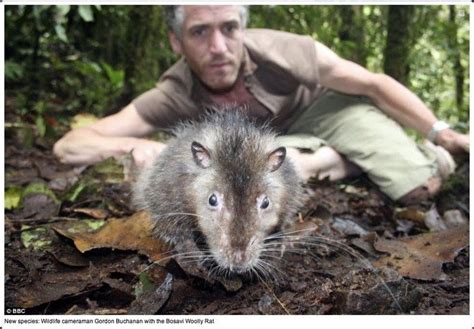
After years of evading detection, a rare, shaggy Spiny Rat, Uromys vika, has been photographed for the first time, offering scientists a crucial glimpse into the life of this elusive rodent native to Vangunu Island in the Solomon Islands.
The Uromys vika, nicknamed the “Woolly Rat” due to its thick fur, was initially discovered in 2017, but capturing photographic evidence of the creature in its natural habitat proved challenging until recently. Tyrone Lavery, a mammalogist and researcher at the University of Melbourne, played a pivotal role in the rat’s initial discovery and subsequent photographic capture. Lavery first learned of the rat’s existence through stories shared by the local Vangunu people. “I started questioning people, showing them pictures of rats, and people were saying, ‘No, no, we’ve got a rat that lives in trees,’” Lavery said in a 2017 interview. These oral accounts led him to search for the unique species, eventually confirming its existence through a single specimen found deceased.
Now, years later, through collaborative efforts involving remote camera traps set up within the rat’s known habitat, researchers have finally obtained clear photographs confirming the species’ physical characteristics and providing invaluable insights into its behavior.
The Woolly Rat is particularly significant due to its size and rarity. It’s one of the largest rat species in the Solomon Islands, weighing up to a kilogram and measuring approximately 45 centimeters (18 inches) in body length, excluding its tail. Its unique, dense fur distinguishes it from other local rat populations. The species is considered critically endangered, primarily due to habitat loss from logging activities that threaten its forest home.
The recent photographic evidence is expected to significantly aid conservation efforts. These images are critical for raising awareness about the rat’s plight and for promoting habitat preservation on Vangunu Island. The local community’s involvement remains crucial, as their traditional knowledge continues to guide conservation strategies. The successful capture of the Woolly Rat on camera underscores the importance of combining scientific research with indigenous knowledge in wildlife conservation. Further studies are planned to better understand the rat’s population size, distribution, and ecological role within its fragile ecosystem.
Discovery and Initial Confirmation
The journey to confirm the existence of the Woolly Rat began in 2017 when Tyrone Lavery embarked on a quest to investigate local reports of a unique tree-dwelling rat on Vangunu Island. His research was driven by the stories shared by the local Vangunu people, who described a rat unlike any other found in the region. These accounts were instrumental in directing Lavery’s initial search efforts.
Lavery’s initial discovery was based on a single specimen found deceased. This discovery was crucial in confirming that the reported unique rat species was indeed real. The specimen allowed for detailed morphological analysis, confirming that it was a distinct species of giant rat, previously unknown to science. This confirmation marked the first formal scientific recognition of the Uromys vika.
The process of formally describing a new species involves rigorous scientific analysis, including detailed measurements, genetic comparisons, and morphological assessments to ensure that the species is truly distinct from all other known species. The discovery of the Uromys vika was particularly significant given the limited biodiversity research conducted in the Solomon Islands, highlighting the potential for further discoveries in this region.
The initial confirmation was based on limited evidence (a single dead specimen), the ability to secure photographic evidence became the top priority for researchers and conservationists alike. High-resolution photographs would provide visual proof of the species’ existence and facilitate public awareness and conservation efforts. The lack of photographic evidence, coupled with the species’ elusive nature, made it challenging to promote its conservation and raise awareness of the threats it faces.
Characteristics and Habitat
The Uromys vika exhibits several unique characteristics that set it apart from other rat species in the region. One of the most notable features is its size. As one of the largest rat species in the Solomon Islands, it can weigh up to one kilogram and measure approximately 45 centimeters in body length, excluding its tail. This substantial size makes it a significant presence within its ecosystem.
Another distinguishing characteristic is its thick, woolly fur, which gives it the nickname “Woolly Rat”. The dense fur provides insulation and protection in its forest habitat. The fur is also thought to play a role in camouflage, helping the rat blend in with its surroundings.
The Woolly Rat is endemic to Vangunu Island, meaning it is found nowhere else in the world. Its habitat is restricted to the island’s remaining patches of primary rainforest. The species is believed to be primarily arboreal, spending much of its time in the trees. This arboreal lifestyle is consistent with the local accounts that initially led to its discovery. Its diet is believed to consist mainly of fruits, nuts, and other forest vegetation. Its specific ecological role within the forest ecosystem is still under investigation. Understanding its dietary preferences and interactions with other species is crucial for effective conservation planning.
The Woolly Rat’s habitat is under significant threat from logging activities. These activities lead to deforestation and habitat fragmentation, reducing the available space for the rat to live and forage. The destruction of its forest habitat also disrupts the broader ecosystem, impacting other species and the overall biodiversity of Vangunu Island.
Conservation Status and Threats
The Uromys vika is currently listed as a critically endangered species by the International Union for Conservation of Nature (IUCN). This designation reflects the high risk of extinction it faces in the wild. The primary threat to its survival is habitat loss due to logging.
Logging operations on Vangunu Island have resulted in the clearing of large areas of primary rainforest, which is the Woolly Rat’s natural habitat. The destruction of its habitat reduces the available food resources and shelter, making it more difficult for the species to survive. Habitat fragmentation further exacerbates the problem by isolating populations and limiting their ability to move and interact with each other.
In addition to habitat loss, the Woolly Rat may also face threats from introduced species. Invasive species can compete with native wildlife for resources, prey on them, or introduce diseases. The impact of introduced species on the Woolly Rat population is currently unknown, but it remains a potential concern.
Conservation efforts are crucial for the survival of the Woolly Rat. These efforts include protecting its remaining habitat, promoting sustainable forestry practices, and raising awareness among local communities about the importance of conservation. Engaging local communities in conservation efforts is essential, as they are the stewards of the land and can play a vital role in protecting the species.
Photographic Evidence: A Breakthrough
The recent capture of photographic evidence of the Uromys vika marks a significant breakthrough in the effort to conserve this elusive species. Obtaining clear photographs of the rat in its natural habitat provides visual proof of its existence and allows for more detailed study of its physical characteristics and behavior.
The photographs were obtained through the use of remote camera traps, which were strategically placed within the rat’s known habitat. These camera traps are triggered by motion or heat, automatically capturing images of any animals that pass by. The use of camera traps is a non-invasive method of studying wildlife, allowing researchers to gather data without disturbing the animals or their environment.
The photographs confirm the Woolly Rat’s unique physical characteristics, including its large size, thick fur, and distinctive facial features. They also provide insights into its behavior, such as its arboreal habits and nocturnal activity patterns. This information is invaluable for informing conservation strategies and monitoring the species’ population.
The photographic evidence also helps to raise public awareness about the Woolly Rat and its plight. Images of the rat can be used in educational materials, media campaigns, and online platforms to promote conservation and garner support for protecting its habitat. The visual appeal of the Woolly Rat can help to capture people’s attention and inspire them to take action.
Community Involvement and Traditional Knowledge
The discovery and subsequent study of the Uromys vika have been greatly aided by the involvement of the local Vangunu people. Their traditional knowledge of the island’s wildlife and ecosystems has been invaluable in guiding research efforts and informing conservation strategies.
Local communities have a deep understanding of the natural world around them, based on generations of experience and observation. This knowledge can provide valuable insights into the distribution, behavior, and ecological role of species like the Woolly Rat. It can also help to identify threats to their survival and develop effective conservation measures.
In the case of the Woolly Rat, local accounts of a unique tree-dwelling rat were instrumental in prompting Tyrone Lavery to investigate its existence. These accounts provided clues about its habitat preferences and behavior, which helped to focus his search efforts. Local guides also assisted Lavery in navigating the island’s rainforests and locating potential habitat areas.
Engaging local communities in conservation efforts is essential for their long-term success. By involving local people in the planning and implementation of conservation projects, it ensures that their needs and perspectives are taken into account. It also empowers them to become stewards of their own natural resources and to play an active role in protecting the environment.
The success of the Woolly Rat conservation effort depends on the continued collaboration between scientists, conservationists, and local communities. By combining scientific expertise with traditional knowledge, it is possible to develop effective strategies for protecting this unique and endangered species.
Future Research and Conservation Plans
The recent photographic evidence of the Uromys vika has opened new avenues for research and conservation. Future studies are planned to better understand the rat’s population size, distribution, and ecological role within its fragile ecosystem.
One of the key priorities is to conduct a comprehensive population survey to estimate the number of Woolly Rats remaining on Vangunu Island. This information is essential for assessing the species’ conservation status and for monitoring the effectiveness of conservation efforts. The survey will involve the use of camera traps, as well as other techniques such as trapping and genetic analysis.
Another important area of research is to investigate the Woolly Rat’s dietary preferences and interactions with other species. This will provide insights into its ecological role within the forest ecosystem and help to identify potential threats to its survival. Researchers will also study its behavior, including its activity patterns, social structure, and reproductive strategies.
Conservation plans for the Woolly Rat include protecting its remaining habitat, promoting sustainable forestry practices, and raising awareness among local communities about the importance of conservation. The establishment of protected areas is crucial for safeguarding the rat’s habitat and ensuring its long-term survival. These protected areas should be managed in a way that is both ecologically sustainable and socially equitable, taking into account the needs and perspectives of local communities.
Sustainable forestry practices can help to reduce the impact of logging on the Woolly Rat’s habitat. These practices include selective logging, which involves harvesting only a small number of trees at a time, and reduced-impact logging, which minimizes damage to the surrounding forest. Promoting sustainable forestry requires collaboration between logging companies, government agencies, and local communities.
Raising awareness among local communities about the importance of conservation is essential for gaining their support for conservation efforts. This can be achieved through educational programs, community meetings, and media campaigns. It is important to emphasize the benefits of conservation for local communities, such as protecting their water resources, preserving their cultural heritage, and promoting sustainable livelihoods.
The conservation of the Uromys vika is a challenging but achievable goal. By combining scientific research, community involvement, and effective conservation strategies, it is possible to protect this unique and endangered species for future generations. The success of this effort will depend on the continued collaboration and commitment of all stakeholders.
The Broader Significance: Biodiversity in the Solomon Islands
The discovery and ongoing research surrounding the Uromys vika underscore the Solomon Islands’ critical role as a biodiversity hotspot. The archipelago is home to a rich array of endemic species, meaning they are found nowhere else on Earth. This high level of endemism makes the Solomon Islands a priority for conservation efforts.
Many of the Solomon Islands’ unique species are threatened by habitat loss, invasive species, and climate change. These threats are particularly acute on smaller islands like Vangunu, where populations are often small and isolated. The conservation of these species requires a multifaceted approach that addresses the underlying drivers of biodiversity loss.
The discovery of the Uromys vika highlights the importance of continued biodiversity research in the Solomon Islands. Much of the archipelago remains unexplored, and there is potential for the discovery of many more new species. Investing in biodiversity research is essential for understanding the region’s unique ecosystems and for developing effective conservation strategies.
The Solomon Islands are also home to a rich diversity of cultures and languages. Local communities have a deep connection to the land and sea, and their traditional knowledge is invaluable for conservation efforts. Engaging local communities in conservation is essential for ensuring its long-term success.
The conservation of biodiversity in the Solomon Islands is not only important for the region itself, but also for the world as a whole. The Solomon Islands are a vital part of the Earth’s natural heritage, and their protection is essential for maintaining the planet’s biodiversity and ecosystem services. The Uromys vika serves as a symbol of the unique and irreplaceable biodiversity of the Solomon Islands, and its conservation is a testament to the power of science, community involvement, and conservation action.
The story of the Woolly Rat serves as a beacon of hope, demonstrating that even in the face of significant environmental challenges, dedicated research, community engagement, and strategic conservation efforts can lead to remarkable discoveries and contribute to the protection of our planet’s precious biodiversity.
FAQ Section
Q1: What is the Uromys vika, and why is it significant?
A: The Uromys vika, also known as the Woolly Rat, is a rare and critically endangered species of giant rat endemic to Vangunu Island in the Solomon Islands. It’s significant because it’s one of the largest rat species in the region, with a unique, thick fur, and its discovery and recent photographic evidence highlight the importance of biodiversity research and conservation efforts in the Solomon Islands. The species is also significant because its continued survival depends on habitat preservation and community engagement, making it a focal point for broader conservation initiatives in the region. “I started questioning people, showing them pictures of rats, and people were saying, ‘No, no, we’ve got a rat that lives in trees,’” Lavery said in a 2017 interview, showing its distinctness from other rat species.
Q2: When was the Uromys vika discovered, and how was its existence confirmed?
A: The Uromys vika was initially discovered in 2017 by Tyrone Lavery, a researcher at the University of Melbourne, based on stories shared by the local Vangunu people. Its existence was first confirmed through a single deceased specimen. This allowed for morphological analysis, confirming it was a distinct, previously unknown species of giant rat. The recent photographic evidence, captured using remote camera traps, further solidifies its existence and provides valuable insights into its behavior and appearance in its natural habitat.
Q3: What are the primary threats to the Uromys vika’s survival?
A: The primary threat to the Uromys vika is habitat loss due to logging activities on Vangunu Island. Deforestation reduces the available food resources and shelter for the rat. Habitat fragmentation also isolates populations, limiting their ability to move and interact. The IUCN lists the species as critically endangered, reflecting the high risk of extinction it faces in the wild.
Q4: What conservation efforts are being implemented to protect the Uromys vika?
A: Conservation efforts for the Uromys vika include protecting its remaining habitat, promoting sustainable forestry practices, and raising awareness among local communities about the importance of conservation. The establishment of protected areas is crucial for safeguarding the rat’s habitat. Engaging local communities in conservation efforts is essential, as their traditional knowledge and stewardship of the land can play a vital role in protecting the species. These efforts are also aided by the visual proof from high-resolution photographs to facilitate public awareness.
Q5: How has the local community been involved in the discovery and conservation of the Uromys vika?
A: The local Vangunu people have been instrumental in the discovery and conservation of the Uromys vika. Their traditional knowledge of the island’s wildlife and ecosystems led Tyrone Lavery to investigate the existence of the unique tree-dwelling rat. Local guides assisted in navigating the rainforests and identifying potential habitat areas. Engaging local communities in conservation efforts is essential for their long-term success, ensuring their needs and perspectives are taken into account and empowering them to become stewards of their natural resources.









